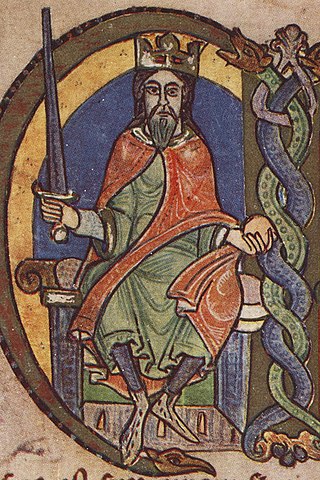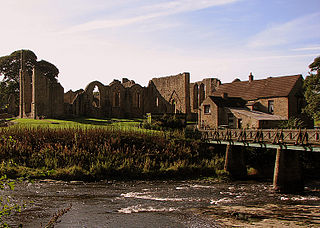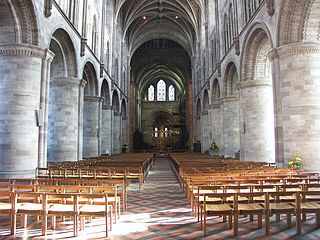Sources
- This article incorporates text from a publication now in the public domain : Chisholm, Hugh, ed. (1911). "Richard of Hexham". Encyclopædia Britannica . Vol. 23 (11th ed.). Cambridge University Press. p. 298.
Richard of Hexham (fl. 1141) was an English chronicler. He became prior of Hexham about 1141, and died between 1155 and 1167. [1] [2]
He wrote Brevis Annotatio, a short history of the church of Hexham from 674 to 1138, for which he borrowed from Bede, Eddius and Symeon of Durham. This is published by James Raine in The Priory of Hexham, its Chroniclers, Endowments and Annals (Durham, 1864 to 1865). More important is his Historia de gestis regis Stephani ci de bello Standardii, very valuable for the history of the north of England during the earlier part of the reign of Stephen, and especially for the Battle of the Standard.
This history, which is a contemporary one, covers the period from the death of Henry I in 1135 to early in 1139. It has been edited for the Rolls Series by Richard Howlett in the Chroniclers of the Reigns of Stephen, Henry II and Richard I, vol. iii. (1886); and has been translated by Joseph Stevenson in the Church Historians of England, vol. iv. (1856).
Beverley, Alfred of, chronicler, and sacrist of the collegiate church of St John the Evangelist and St John of Beverley wrote a history of Britain and England in nine chapters from its supposed foundation by the Trojan Brutus, down to the death of Henry I in 1135. Alfred's chief sources, in addition to Bede's Historia Ecclesiastica de Gentis Anglorum, are Geoffrey of Monmouth's Historia Regum Britanniae, Henry of Huntingdon's Historia Anglorum, The Chronicle of John of Worcester, and the Historia Regum, attributed to Symeon of Durham.e

David I or Dauíd mac Maíl Choluim was a 12th-century ruler who was Prince of the Cumbrians from 1113 to 1124 and later King of Scotland from 1124 to 1153. The youngest son of Malcolm III and Margaret of Wessex, David spent most of his childhood in Scotland, but was exiled to England temporarily in 1093. Perhaps after 1100, he became a dependent at the court of King Henry I. There he was influenced by the Anglo-French culture of the court.
Symeonof Durham was an English chronicler and a monk of Durham Priory.

Miles FitzWalter of Gloucester, 1st Earl of Hereford was a great magnate based in the west of England. He was hereditary Constable of England and Sheriff of Gloucestershire.

Acca of Hexham was an early medieval Northumbrian prelate, serving as bishop of Hexham from 709 until 732, and subsequently commemorated as a Christian saint.
Robert Surtees was a celebrated English historian and antiquary of his native County Durham.

Finchale Priory sometimes referred to as Finchale Abbey was a 13th-century Benedictine priory. The remains are sited by the River Wear, four miles from Durham, England. It is a Grade I listed building.

The relationship between the Kingdom of England and King David I, who was King of Scotland between 1124 and 1153, was partly shaped by David's relationship with the particular King of England, and partly by David's own ambition. David had a good relationship with and was an ally of Henry I of England, the King who was largely responsible for David's early career. After Henry's death, David upheld his support for his niece, the former Empress-consort, Matilda, and expanded his power in northern England in the process, despite his defeat at the Battle of the Standard in 1138.
Robert or sometimes Robert of Lewes was a medieval English Bishop of Bath. He began his career as a monk at Lewes Priory as well as performing administrative functions for Henry of Blois. It was Henry who secured Robert's selection as bishop. While bishop, Robert built in his diocese and set up the system of archdeacons there. He may have been the author of the Gesta Stephani, a work detailing the history of King Stephen's life.

Robert de Bethune was a medieval bishop of Hereford. From a knightly family, he became a teacher before becoming a canon by 1115. He was elected prior of Llanthony Priory in the middle 1120s, and was named bishop by King Henry I of England in 1130. As bishop, he was often appointed a judge by the papacy, and was known for the care he took of his diocese.
Pehthelm was the first historical bishop of the episcopal see of Candida Casa at Whithorn. He was consecrated in 730 or 731 and served until his demise. His name is also spelled as Pecthelm, Pechthelm, and sometimes as Wehthelm.
Beadwulf was the last Bishop of Candida Casa to be consecrated by the Northumbrian Archbishop of York. He appears in four years of the chronicles and nowhere else. Nothing else is known of him, and his sole historical significance is that he was a bishop of the short-lived Northumbrian See of Candida Casa at Whithorn.
William Cumin was a bishop of Durham, and Justiciar of Scotland.

John Gough Nichols (1806–1873) was an English painter and antiquary, the third generation in a family publishing business with strong connection to learned antiquarianism.

Tidfrith or Tidferth was an early 9th-century Northumbrian prelate. Said to have died on his way to Rome, he is the last known Anglo-Saxon bishop of Hexham. This bishopric, like the bishopric of Whithorn, probably ceased to exist, and was probably taken over by the authority of the bishopric of Lindisfarne. A runic inscription on a standing cross found in the cemetery of the church of Monkwearmouth is thought to bear his name.
The Surtees Society is a text publication society and registered charity based in Durham in northern England. The society was established on 27 May 1834 by James Raine, following the death of the renowned County Durham antiquarian Robert Surtees. Raine and other former friends of Surtees created the society to honour his memory and carry on his legacy, with the focus on publishing documents relating to the region between the Humber estuary and Firth of Forth in the east and the River Mersey and the River Clyde in the west, the region that had once constituted the kingdom of Northumbria. Membership of the Society is by annual subscription. Members receive the book published for the year of subscription.

James Raine (1791–1858) was an English antiquarian and topographer. A Church of England clergyman from the 1810s, he held a variety of positions, including librarian to the dean and chapter of Durham and rector of Meldon in Northumberland.

Lawrence of Durham was a 12th-century English prelate, Latin poet and hagiographer. Born in southern England, at Waltham in Essex, Lawrence was given a religious education, and excelled at singing and poetry composition. In his youth Lawrence joined Durham Cathedral Priory and became a Benedictine monk. In the 1130s Lawrence became a courtier of Geoffrey Rufus, bishop of Durham.
Robert de Graystanes, also known as Robert Greystones or Robert Graystanes, was a 14th-century English Benedictine monk, an unsuccessful candidate to become bishop of Durham around 1333, and supposed chronicler of the church of Durham.
Geoffrey of Coldingham was a late 12th and early 13th-century monk and chronicler.